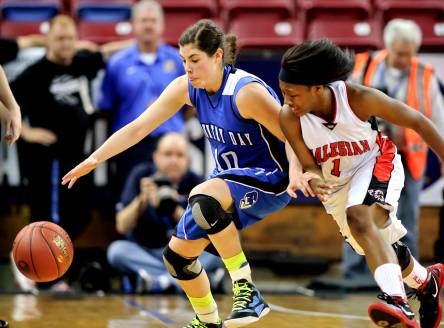
Players like La Jolla Country Day's Kelsey Plum, left, appreciate the benefits of Title IX, which is now 40 years old.
Photo by Gary Jones
No person in the United States shall, on the basis of sex, be excluded from participation in, be denied the benefits of, or be subjected to discrimination under any education program or activity receiving federal financial assistance.
For a lot of people, Title IX – which is quoted in full above – is ancient history. After all, it was passed in 1972, and for the girls at the USA Basketball Under 17 and Under 18 tryouts in Colorado Springs this weekend, Title IX had been the law of the land for 22 years, which is before they were even born.
So for them, the idea that girls wouldn't be allowed to play high school sports, or thought too frail to be involved in a contact sport like basketball, is incomprehensible. But there are still a lot of folks around who remember when girls were given one whole day in high school to be athletes – the rest of the time they were just supposed to cheer on the guys.
And those folks remember when the sight of a gym full of girls playing basketball was as unlikely as the sight of an African-American sitting at the front of a Southern bus in 1951.
But how far have the girls really come? Do they get treated the same as the male basketball players in high school? Do they get the same respect?
To try and answer these questions, we conducted a random and completely unscientific survey at the USA Basketball tryouts, and the results show that for the most part, schools and administrators treat the girls as well as the boys. One major exception, though, was a school in Florida, at which one U-17 participant said her team often had to cancel practice so the boys could use the gym, and didn't have access to the same facilities.
Otherwise, however, equity ruled.
Kianna Holland of
Seneca (S.C.) actually went a little further: "We get treated as well if not better. We got new locker rooms."
Kelsey Plum of
La Jolla Country Day (Calif.) even says "We get more fans at our games," but that's definitely an exception.
Even though schools as an organization alternate practice times and facilities so girls and boys have equal access, the presence of elite players and state championship teams doesn't necessarily draw the attention of the student body.
"They get more exposure," said
Linnae Harper of
Whitney Young (Chicago), "even though we play harder than the guys" – not to mention that Harper's Dolphins won a state title and finished the season No. 2 in the Xcellent 25. "They have games televised and we have to beg to get on TV."
Taya Reimer of
Hamilton Southeastern (Fishers, Ind.) said it's a league policy that the boys play on Friday nights while the girls play on either Wednesday or Saturday. There's one game that the girls get to play a doubleheader with the boys.
In general, though, girls' teams do play at the same site and on the same night, though they play first. That's good, the players said, because then fans will come for the second half of the girls' game.
And in general, the players are at least peripherally aware of Title IX. Some had had it brought up in class this year, and others knew the name, though they thought it mainly had to do with basketball and not necessarily access to other sports and activities. About a third of our participants, however, answered with a variation of "What's Title IX?"
But even if all the girls don't know their 1970s history, clearly the vast majority of school administrators do, and the facilities and opportunities for female basketball players are pretty much equal.
"I think Title IX is great," said Plum, "and the perfect example is here."
And she pointed to the other players, the gym, the coaches and the media, who were all present to watch girls play the game of basketball at a very high level, something that never would have been possible prior to 1972.
